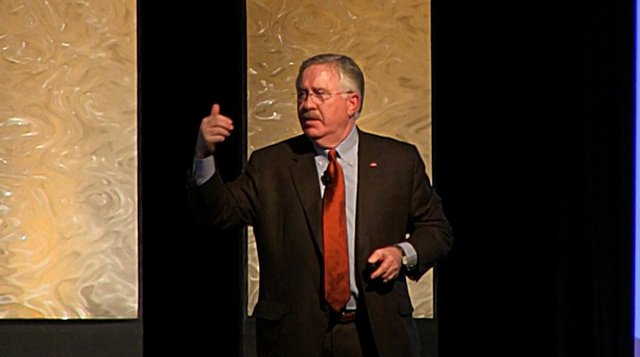By Cliff Ennico
If you own your own business and you’ve never heard of Jim Blasingame, you’re missing out on a lot.
For donkey’s years now, Jim has hosted a popular nationally syndicated radio show called “Small Business Advocate” (www.smallbusinessadvocate.com), which is probably the best talk radio program in the country devoted to the world of small business (I think it may be the only such program, but that’s a quibble). As a radio personality, Jim is avuncular, provocative, opinionated, pigheaded stubborn, Three Stooges funny, and probably the best “advocate” for small business on the airwaves (full disclosure: I am a frequent guest on Jim’s show, and we’re friends despite the fact he thinks he knows more 1970s classic rock trivia than I do).
But now Jim has gone ahead and done it. He’s really made me mad this time. He’s gone ahead and written the first small business book in a long time that I wish I had written. It’s called “The Age of the Customer: Prepare for the Moment of Relevance,” and he wrote and published it all by himself (http://ageofthecustomer.com)..
His three big messages are contained in the book’s title and subtitle. To wit:
the Internet, social media and mobile technology have empowered your customer to a degree unparalleled in human history;
while you still control your product or service, your customer now controls your brand message; and
because of that, it is more important for small businesses to be relevant to the customer than to be competitive with other sellers.
Now, these aren’t exactly new messages (sorry, Jim). For years I’ve been telling folks that you have to seduce or “pull” your customers to you on the Internet rather than “push” your sales message in their faces, and there are a lot of books and motivational speakers out there telling you that your business has to have a website, take advantage of social media, be visible to smartphones, yada, yada. But Jim’s book is the first I’ve seen that tells you exactly why all this is important for you and your business.
One example in Jim’s book that really hit home to me was a story of two Italian restaurants in a small town (you probably can guess why I picked this one). One has better pasta and is cheaper, the other is expensive and the food isn’t all that good. They both have websites, but the expensive restaurant’s website has been optimized for mobile phones. A businessperson is visiting that town and is looking for a good Italian restaurant.to host a client meeting. He turns to his smartphone’s geolocation app looking for the nearest great Italian restaurant. Guess which one shows up? (If the guy’s on an expense account he probably would have picked the more expensive restaurant anyway, but never mind).
One of Jim’s more powerful insights is that “once a new capability or advantage is available to customers and adopted, that becomes their new minimum expectation.” This is truly a sea change in the way people think. For countless generations people were afraid of change and were slow to adapt to new technologies of any kind. Even quite recently, it look the Baby Boomers almost 10 years (from 1976 to 1986) to adopt the personal computer.
Today, we’ve become accustomed to quantum leaps in technology. Witness the recent Consumer Electronics Show in Las Vegas, which generally got unenthusiastic reviews because no new “game changing” devices were announced. Or the growing number of people worried about the future of Apple Inc. (the largest company in America by capitalization) because they haven’t launched a revolutionary new product for two years running.
More and more people are becoming “early adopters,” jumping onto bandwagons before they even hear the music. If you’ve ever tried sending e-mail messages to young people who communicate mainly by instant messaging, you know what Jim is talking about.
Here are some more of Jim’s more piquant (if not pungent) observations:
- Customers are responding less to mass marketing and more to values-based communities;
- User generated content represents the two-edged sword by which brands, large and small, will live and die;
- Interests and community will increasingly trump generational, ethnic and gender influences;
- In the Age of the Customer, your customers co-own your brand message;
- Business-to-business (B2B) customers are looking more for partners than they are vendors;
- A quality process or system is more important than quality service;
- Outsourcing by large businesses is one of the best things that has ever happened for small businesses; and
- (My personal favorite) it’s redundant to say “undercapitalized small business”
If Jim’s message can be boiled down to a single sentence, it’s that every small business needs to be not only customer oriented but customer centric, because you and your customers are no longer acting at arm’s length but will be increasingly part of a shape-shifting and highly networked online community.
A great message not only for today’s tech-driven times, but for all time.
Cliff Ennico (cennico@legalcareer.com) is a syndicated columnist, author and host of the PBS television series ‘Money Hunt’. This column is no substitute for legal, tax or financial advice, which can be furnished only by a qualified professional licensed in your state. To find out more about Cliff Ennico and other Creators Syndicate writers and cartoonists, visit our Web page at www.creators.com. Copyright 2013 Clifford R. Ennico. Distributed By Creators Syndicate, Inc. Follow Cliff: @cliffennico.







